|
Printables |
PowerPoints |
Online exercises |
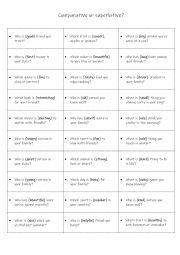
|
Comparative or superlative sentence practise 2 B
This worksheet is suitable for CEFR A2 level students. A 30 generic question worksheet using the same adjectives in worksheet 2 A.Students reinforce the comparative or superlative grammar part with a speaking component.
Level: elementary
Age: 9-100
Type:
Downloads: 103
|
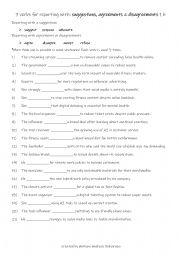
|
7 verbs for reporting with suggestions, agreements & disagreements 1 b
First, students need to familiarise themselves with the verbs and check their meaning and use. Then they read the sentences to see which verb is needed to complete the sentence. Each verb is used 3 times! Answers on page 2.
Level: elementary
Age: 8-100
Type:
Downloads: 106
|
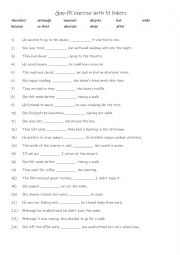
|
B1 11 Linkers practise with 24 sentences
Linkers help clarify the relationships between ideas in both spoken and written communication. For instance, "however" shows a contrast between two ideas, while "because" indicates a reason.In formal writing, especially academic and professional contexts, the proper use of linkers is crucial for articulating complex ideas clearly and persuasively. ...
Level: intermediate
Age: 10-100
Type:
Downloads: 113
|
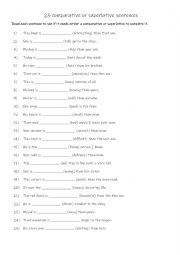
|
Comparative or superlative sentence practise 1 A
Students read each sentence to see if it needs either a comparative or superlative to complete it. Answers on page 2. In worksheet 1 B there is a generic speaking reinforcement activity using 25 of the base form adjectives in this worksheet.
Level: elementary
Age: 9-100
Type: worksheet
Downloads: 128
|
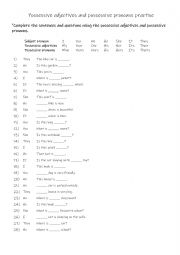
|
Possessive adjectives and possessive pronouns practise
Students complete the sentences and questions using the possessive adjectives and possessive pronouns. This worksheet is suitable for low A1-A2 students.Answers on page 2.
Level: elementary
Age: 10-100
Type: worksheet
Downloads: 119
|
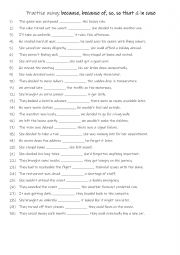
|
A2-B1 Practise using: because, because of, so, so that & in case 1
Learning to use "because," "because of," "so," "so that," and "in case" helps improve clarity and precision in communication. These phrases allow you to explain reasons ("because," "because of"), show results ("so"), indicate purpose ("so that"), and talk about future possibilities ("in case"). Mastering these structures enhances your ability to pr...
Level: elementary
Age: 8-100
Type:
Downloads: 106
|
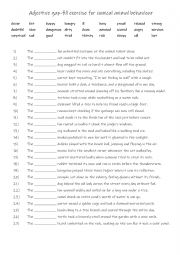
|
A2+ - B1+ Adjective gap-fill exercise for comical animal behaviour
Students familiarise themselves with the 27 adjectives. Then they read the sentences to see which adjective is needed to complete the gap-fill. Answers on page 2.
Level: intermediate
Age: 9-100
Type:
Downloads: 116
|
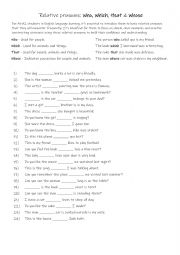
|
Relative pronouns: who, which, that & whose
For A1-A2 students in English language learning, it�s essential to introduce them to basic relative pronouns that they will encounter frequently. It�s beneficial for them to focus on simple, clear examples and practice constructing sentences using these relative pronouns to build their confidence and understanding. Answers on page 2.
Level: elementary
Age: 8-100
Type:
Downloads: 131
|
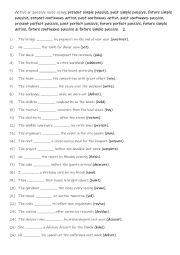
|
B1-B2 Active or passive voice using: present simple passive, past simple passive, future simple passive, present continuous active, past continuous active, past continuous passive, present perfect passive, past perfect passive, future perfect passive, fut
Students familiarise themselves with the tenses and use, then they read the sentences to work out which one is needed to complete the gap-fill using the infinitive in (). Answers on page 2.
Level: intermediate
Age: 10-100
Type:
Downloads: 107
|
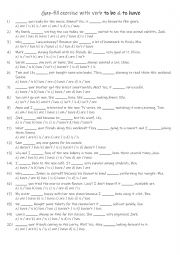
|
A1+-A2 Present simple multiple choice with verb to be & to have
Students read the present simple sentences to see which auxiliary verb is needed to complete the gap-fills. Answers on page 2.
Level: elementary
Age: 8-100
Type:
Downloads: 107
|
|
|
|
|












